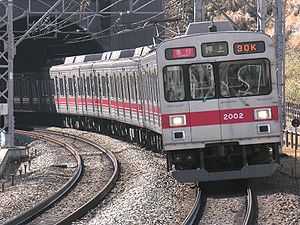Tokyu 2000 series
| Tokyu 2000 series | |
|---|---|
 A 2000 series set on the Den-en-toshi Line, February 2008 | |
| In service | 1992–Present |
| Manufacturer | Tokyu Car Corporation |
| Constructed | September 1992–1993 |
| Number built | 30 vehicles (3 sets) |
| Number in service | 30 vehicles (3 sets) |
| Formation | 10 cars per set |
| Operator | Tokyu Corporation |
| Depot(s) | Nagatsuta |
| Line(s) served | Tōkyū Den-en-toshi Line, Tokyo Metro Hanzomon Line |
| Specifications | |
| Car body construction | Stainless steel |
| Car length | 20,000 mm (65 ft 7 in) |
| Width | 2,800 mm (9 ft 2 in) |
| Doors | 4 pairs per side |
| Maximum speed | 110 km/h (70 mph) |
| Acceleration | 3.3 km/h/s |
| Deceleration |
3.5 km/h/s (service) 4.5 km/h/s (emergency) |
| Electric system(s) | 1,500 V DC |
| Current collection method | overhead |
| Safety system(s) | CS-ATC |
| Track gauge | 1,067 mm (3 ft 6 in) |
The Tokyu 2000 series (東急2000系 Tōkyū 2000-kei) is a Japanese commuter electric multiple unit (EMU) train type operated by Tokyu Corporation on Tokyu Den-en-toshi Line and Tokyo Metro Hanzomon Line inter-running services in the Tokyo area since 1992. Only three 10-car sets were built.[1]
Operations
The 2000 series sets are used on Tokyu Den-en-toshi Line and Tokyo Metro Hanzomon Line inter-running services, but are not capable of running through onto the Tobu Isesaki Line, and have circular "K" stickers on the centre front cab window to indicate this.[1]
Design
Based on the earlier Tokyu 9000 series EMU design, two sets were introduced in 1992, followed by a third in 1993.[1] The first two sets were delivered with roller blind destination indicators, whereas the third set was delivered from new with 3-colour LED destination indicators.[1] All three sets have since been modified with full-colour LED destination indicators.[1]
Formations
The 10-car sets consist of six motored (M) cars and four unpowered trailer (T) cars, formed as shown below, with car 1 at the Shibuya end.[2][3]
| Car No. | 1 | 2 | 3 | 4 | 5 | 6 | 7 | 8 | 9 | 10 |
|---|---|---|---|---|---|---|---|---|---|---|
| Designation | Tc2 | M2 | M1 | T2 | M2 | M1 | T1 | M2 | M1 | Tc1 |
| Numbering | 2000 | 2250 | 2200 | 2700 | 2350 | 2300 | 2800 | 2450 | 2400 | 2100 |
| Weight (t) | 27.8 | 33.1 | 34.7 | 26.2 | 33.1 | 34.7 | 27.2 | 33.1 | 34.7 | 27.8 |
| Capacity (total) | 130 | 144 | 144 | 144 | 144 | 144 | 144 | 144 | 144 | 130 |
The M1 cars are each fitted with one lozenge type pantograph.[3]
Interior
Seating is longitudinal bench seating throughout.[1] Cars 3 and 9 have wheelchair spaces.[2]
-

Interior view
-

Interior view of car 3, showing the wheelchair sace
History

The first two sets entered service on the Den-en-toshi Line in September 1992.
References
- ↑ 1.0 1.1 1.2 1.3 1.4 1.5 私鉄車両年鑑2012 [Japan Private Railways Annual 2012]. Tokyo, Japan: Ikaros Publications Ltd. February 2012. p. 143. ISBN 978-4-86320-549-9.
- ↑ 2.0 2.1 私鉄車両編成表 2012 [Private Railway Rolling Stock Formations - 2012]. Japan: JRR. July 2012. p. 68. ISBN 978-4-330-29911-2.
- ↑ 3.0 3.1 Watanabe, Mineo (May 1992). "東急2000系" [Tokyu 2000 series]. Japan Railfan Magazine (Japan: Koyusha Co., Ltd.) 32 (373): p.29–33.
| Wikimedia Commons has media related to Tokyu 2000 series. |
| ||||||||||
